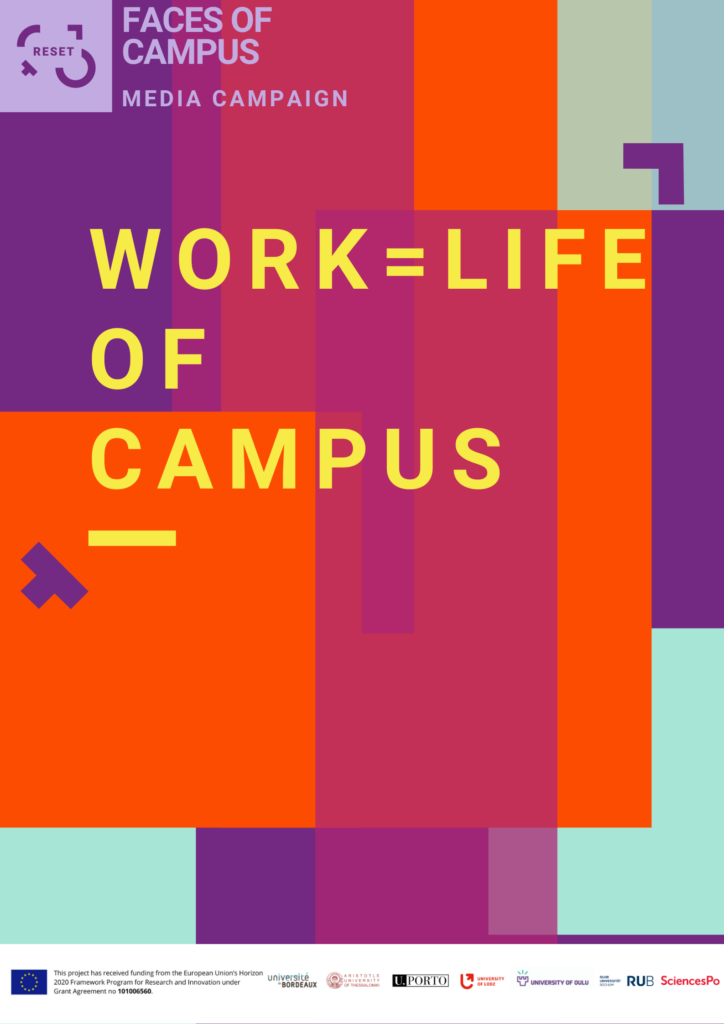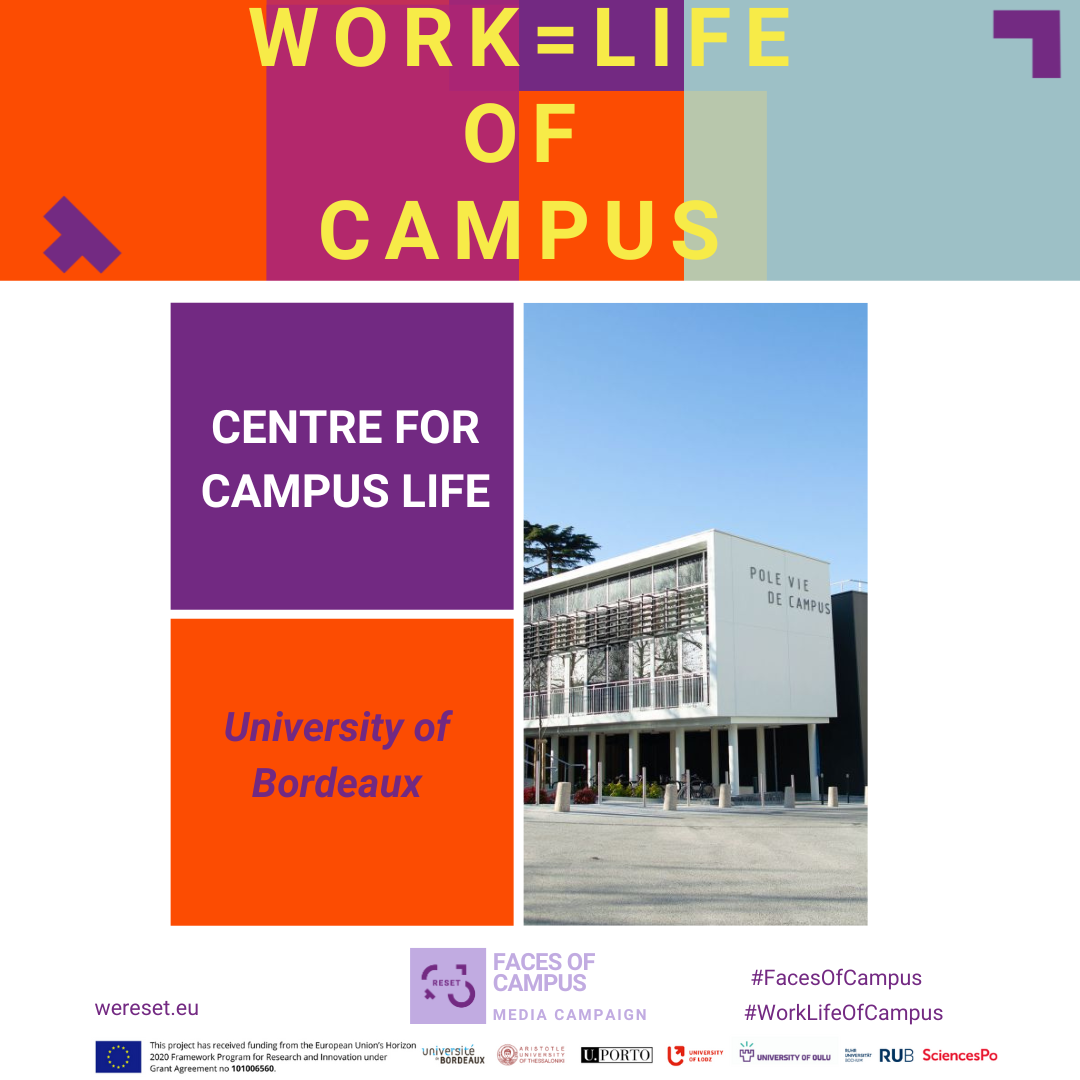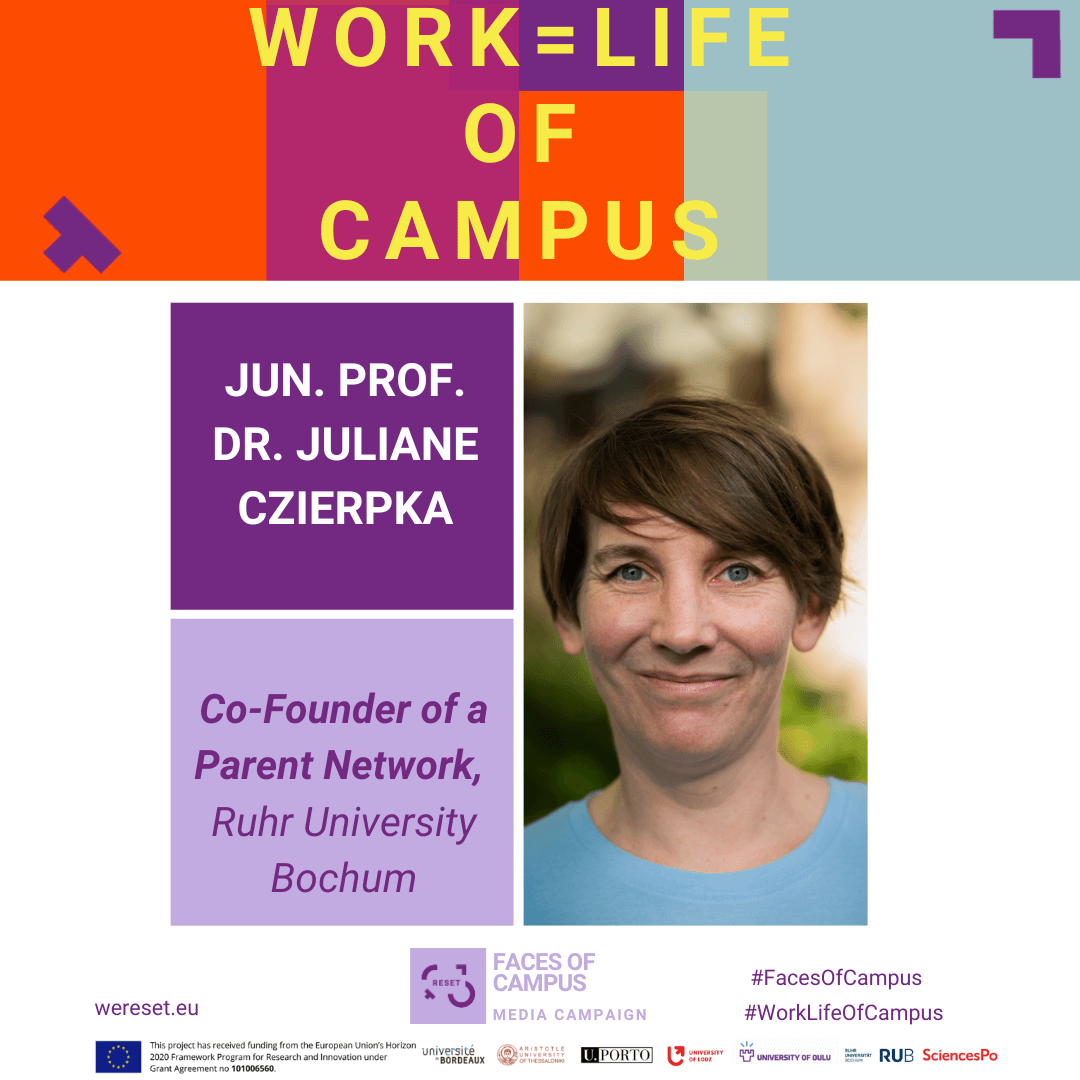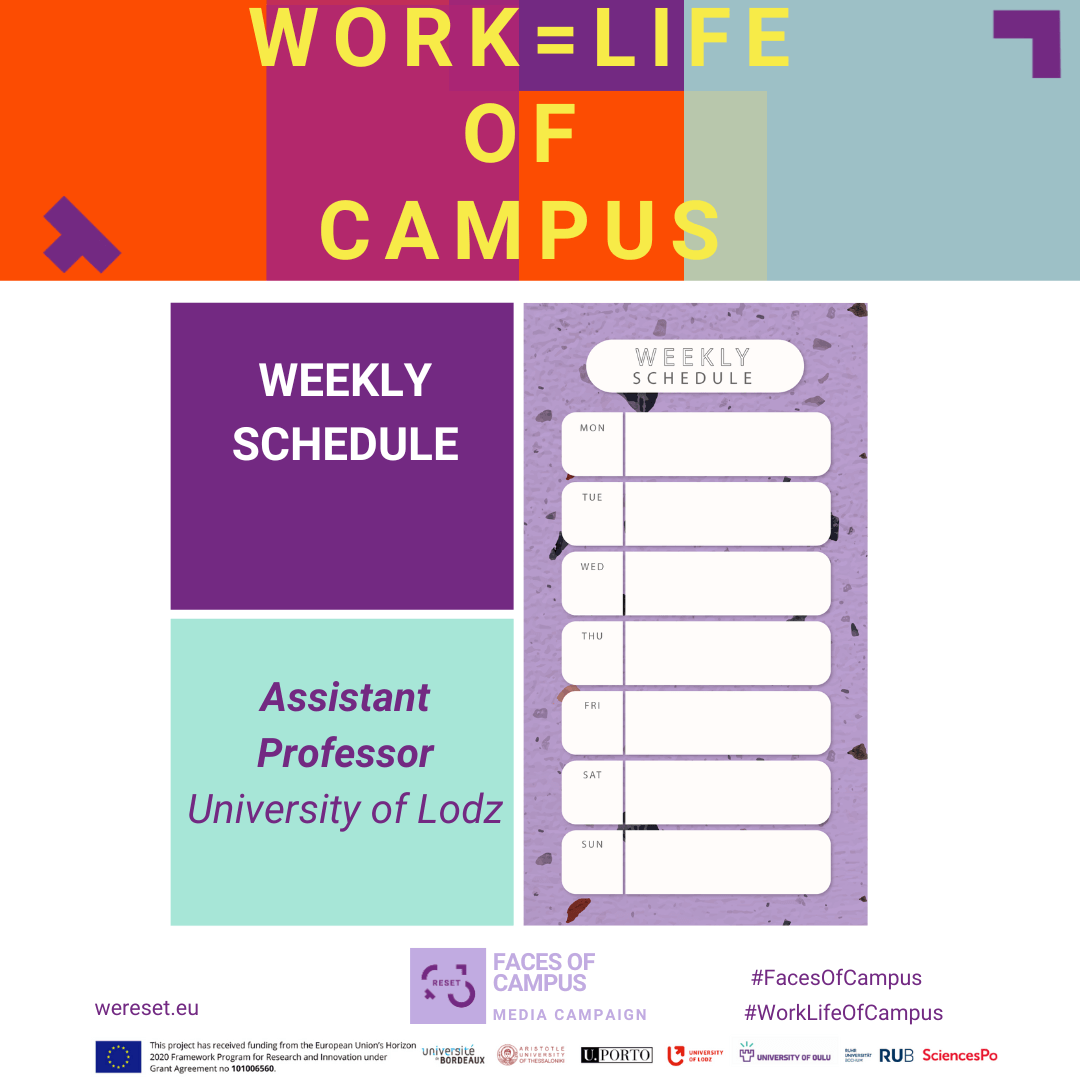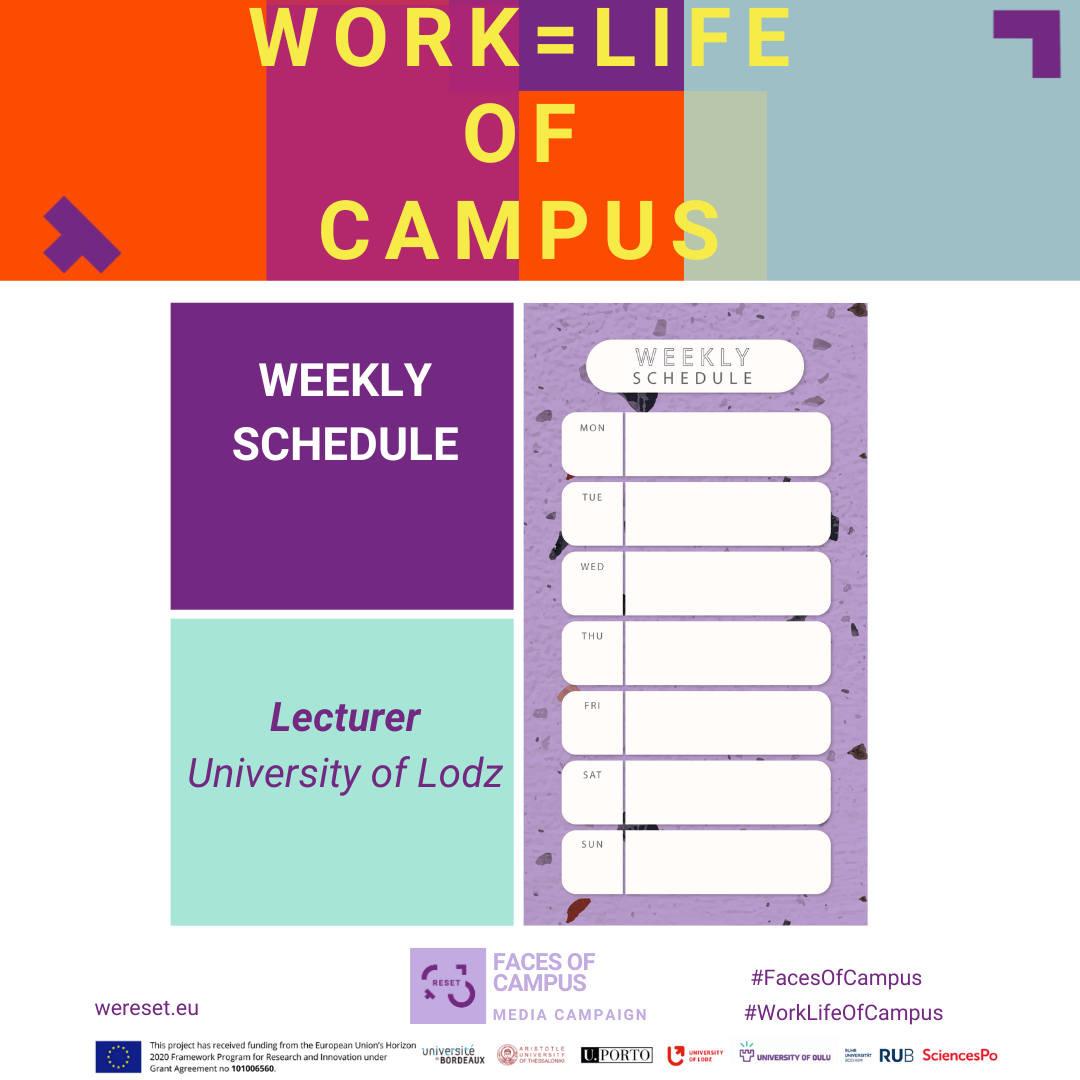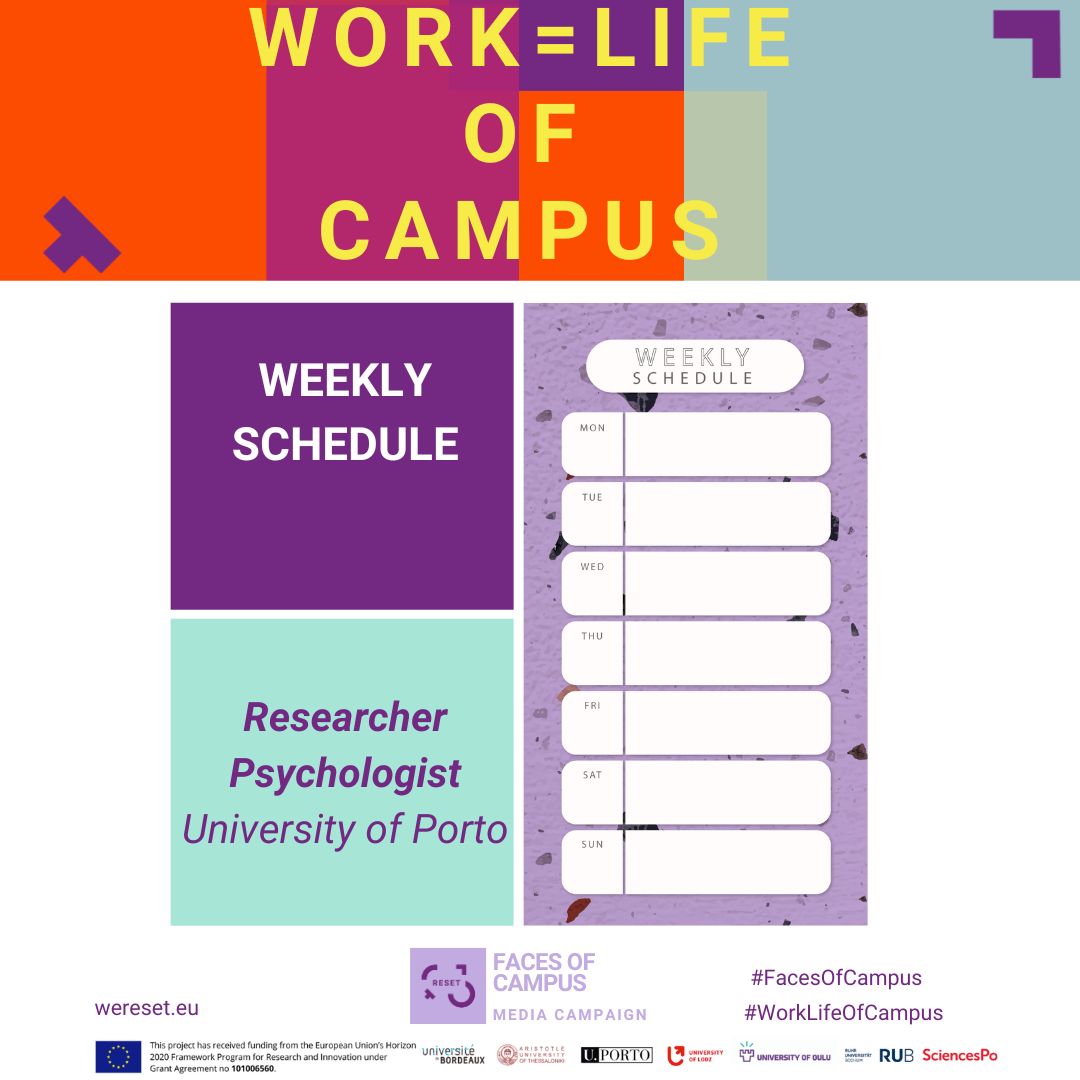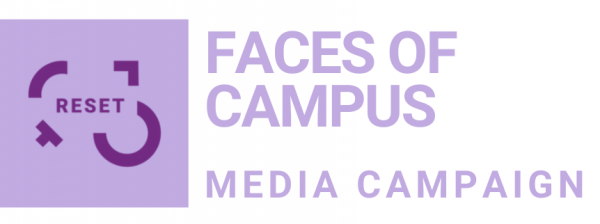
With WORK=LIFE OF CAMPUS, RESET continues its media campaign FACES OF CAMPUS. The campaign aims to highlight aspects of academic life that are sometimes less visible but, nonetheless, important for scientific excellence. In 2022, RESET launched FACES OF CAMPUS with the digital exhibition “Behind the Scenes” portraying contributions of women in research supporting positions.
Text written by Viktoria Niebel, RESET Team at Ruhr University Bochum
In 2023 the exhibition WORK=LIFE OF CAMPUS will present spaces and initiatives of our universities dedicated to the promotion of well-being at work and in studies. This campaign aims at sharing perspectives, experiences and approaches applied by researchers, teachers and students as well as institutional initiatives towards work- and study- life balance. In particular, we will highlight family-related factors, such as parenthood and care responsibilities.
About WORK=LIFE OF CAMPUS: Focal points of the Exhibition
Work Life
Balance
Family
Life
Spaces & Initiatives
Why work-life balance?
Work-life balance refers to the reconciliation of the different social roles and environments in our daily lives. Here, the relation between work and non-work plays a central role (Richert-Kaźmierska & Stankiewicz 2016). At the same time, it is a term that is not clearly defined, but instead is both a social construct and a discourse (Lewis & Beauregard, 2018). It is clear that WLB is subject to personal and institutional negotiations and practices. Thus, reconciling work with other areas of life can involve many different dimensions, such as health, family, social activity and personal interests, as well as community engagement (Land & Taylor, 2010). Here, it is important to consider that structural, cultural, and practical aspects extend beyond the individual question of balance and narrow the options of what can be understood as ‘balance’, As claims that are attached to the strive for work-life balance point beyond a balance between work and non-work, the term can even be misleading (Lewis & Beauregard, 2018).
For both academics in the qualification phases and for professors, the challenges lie within a systemic pressure to publish, a fast pace of diverse work processes and demands in research and managing research projects, as well as in teaching and academic self-governance (Santos & Cabral-Cardoso 2008). These are processes that raise not only the question of work-life balance, but also that of ‘work-work balance’ and self-directed time management (Griffin, 2022; Israel 2019). The fact that ‘work’ is often unilaterally equated with paid work, while care work as part of ‘life’ is assigned to leisure time, is also reflected and criticized. However, this division illustrates the different nuances addressed by work-life balance and reinforces an idea that no clear dividing lines can be drawn between work and leisure and that the field of care has a separate role to play here (Lewis & Beauregard, 2018). At the same time, they point to an inherent gendered component (Connell, 2005).
Work-life balance issues thus affect various aspects of work, as well as personal life. RESET aims to draw attention to the workload inherent in the academic workplace. In particular, we highlight the need to be aware of the risks to well-being that affect both the physical and mental health of employees. Related to this, RESET sees the need for policies that address work life balance to affect the structures, cultures, and practices of the organization (Lewis & Beauregard, 2018). In academia, this also means looking at the systemic demands on academics and the understanding of scientific excellence.
A gendered vision towards Work-Life Balance
The COVID-19 pandemic exacerbated care situations for parents – and especially mothers (EIGE, 2022). It has sharpened and brought into the centre of attention a condition that presents a double burden on parents among researchers and students (Garraio et al., 2022; Minello et al. 2021). Related to this, the balance between work and family, as well as other aspects of life, is an issue that concerns both employees and employers and is systematically intertwined with inequality, especially in the field of science (Górska et al., 2021).
From a gender perspective, balancing of work and private life – especially in relation to care tasks – has long been the subject of research (e.g., Benshop & Verloo, 2006; Lewis & Humbert, 2010; Matias et al. 2022). On the one hand, this involves the questions of the extent to which parents are impaired in their career development in the field of science, and how it affects women (Hendrix, 2017). At the same time, regarding the conception of science and academic subjects, it can be noted that the problem of parenthood is often attributed to women, making them seen as potential mothers and, therefore, potential absent workers. (Bomert & Leinfeller, 2017; Paulitz et al. 2015; Thébault & Taylor, 2017). In this context, mothers in academia are charged with balancing and managing these different roles (CohenMiller & Izekenova 2022).
This illustrates the problematization of parenthood in academia, and links it to the societal problem of the gender care gap (EIGE, 2019). It is entangled with the dynamics of gendered relationships and internalised within gender roles that affect partnerships, the distribution of care, the participation in the labour market, and self-relations (Lauggas, 2021; Thébault & Taylor, 2017). At the same time, it cannot be solely attributed to the individual academics, but is connected to the systemic structure of academic work. This is where both issues of work cultures and employer’s support become relevant.
Family Life: Discussing Fatherhood
Since August 2019, the European “Directive of the European Parliament and of the Council on work-life balance for parents and carers and repealing” has been in place, which sets standards for the compatibility policy of the member states.
This provides for the following measures:
- Ten days of paid time off for the second parent around the birth of the child. It must be guaranteed at least the same amount of wage replacement as sick pay.
- Four months of parental leave for each parent, two of which are paid and not transferable to the other parent.
- Five days of time off for caregiving per year.
- Right to request flexible work arrangements for parents and family caregivers.
- Better protection against dismissal for parents and family caregivers. (BMBF, 2020, p. 27)
Although these measures also actively address men’s participation in parenting and caring for relatives and grant them entitlements, the gender care gap in Europe remains high. (Koslowski & O’Brien, 2022; Moran & Koslowski, 2019).
The link between scientific careers and parenthood is often addressed in relation to the conditions and burdens for mothers. This is hardly surprising, since they are particularly concerned with the stresses of parental leave and re-entry into the workforce (Blum et al. 2018). In addition, fathers are much less likely to take parental leave, and when they do, it is much shorter. This is true for men both inside and outside of academia, and increases the need to bring this issue into focus, and make active fatherhood, as well as the negotiation of care in parenting, more visible (Grau Grau & Bowles, 2022; Koslowski & Kadar-Satat, 2019). The effect is intensified in families where fathers have precarious employment contracts (Koslowski & O’Brien, 2022). There is also a cultural component in which active fatherhood still faces barriers. These include fathers’ concerns about their career opportunities, as well as concerns about negative perceptions of the environment regarding parental leave (Koslowski & Kadar-Satat, 2019).
Striving for gender equity also means sharing care work within families and leaving access to paid work open to all. At the same time, there are obstacles, due to the still insufficient acceptance and support for care work by men, whether cultural, institutional or personal. Accordingly, there is often a lack of role models and models that offer orientation and show that there are other forms in which the division of care work and co-parenting are possible.
Family-Life: Care for elders and partners
Often suddenly, the need to care for a relative or partner can arise. This is connected to a high degree of emotional stress and uncertainty. It also implies logistical issues, and the reconciliation of work and care must be balanced. In RESET, we emphasize the importance of institutions supporting their employees in these care tasks and difficult times. This support represents an active contribution to the promotion of work-life balance. In this context, the support can help to reduce the gender care gap.
Spaces: Rooms and initiatives
With Faces of Campus, in this second edition, we will not only present people working and studying at the RESET universities, but also put in the spotlight the face of the sites on campus, where rest and regeneration, as well as support for the university everyday life are offered. With this, we also want to offer inspiration from different RESET universities to redesign spaces and actively engage for work-life balance.
Especially now, in a time that has been strongly influenced by the COVID-19 pandemic, rooms and spaces stand in a new light: They offer a change of place, are spheres of encounter, or of deepening and contemplation. They help to mark a difference between the private and professional environment, and at the same time contribute to the well-being at work.
Through examples from initiatives at various RESET universities, we present collaborative efforts to promote work-life balance and issues of gender equity and advocacy for more equitable care distribution.
Literature:
- Benschop, Yvonne and Verloo, Mieke (2006). ‘‘Sisyphus’ sisters: can gender mainstreaming escape the genderedness of organizations?’’, Journal of Gender Studies, Vol. 15 No. 1, pp. 19-33.
- BMBF (2020). Was der Gender Care Gap über Geld, Gerechtigkeit und die Gesellschaft aussagt. Einflussfaktoren auf den Gender Care Gap und Instrumente für seine Reduzierung. https://www.bmfsfj.de/resource/blob/154696/bb7b75a0b9090bb4d194c2faf63eb6aa/gender-care-gap-forschungsbericht-data.pdf
- Blum, Sonja, Koslowski, Alison, Macht, Alexandra, Moss Peter (2018) International review of leave policies and research. https://www.leavenetwork.org/fileadmin/user_upload/k_leavenetwork/annual_reviews/Leave_Review_2018.pdf
- Bomert, Christiane & Leinfellner, Stefanie (2017). “Images, ideals, and constraints in times of neoliberal transformations: Reproduction and profession as conflicting or complementary spheres in academia?” European Educational Research Journal, 16, 106–122. Doi: doi.org/10.1177/1474904116682972
- CohenMiller, Anna & Izekenova, Zhanna (2022). “Motherhood in Academia during the COVID-19 Pandemic: An International Online Photovoice Study Addressing Issues of Equity and Inclusion in Higher Education”. Innovative Higher Education (2022). Doi: doi.org/10.1007/s10755-022-09605-w
- Connell, R.W. (2005). A Really Good Husband. Work/Life Balance, Gender Equity and Social Change. Australian Journal of Social Issues Vol.40 No.3, 369-383.
- EIGE (2019). Gender Equality Index. Work-life Balance. https://eige.europa.eu/sites/default/files/documents/mhaf19101enn_002.pdf
- EIGE (2022). Gender Equality Index. The COVID-19 Pandemic and Care. https://eige.europa.eu/sites/default/files/documents/gender_equality_index_2022_corr.pdf
- Garraio, Carolina, Freitas, Jorge Peixoto, Magalhães, Sara Isabel & Matias, Marisa (2022). “Work-Life Conflict Among Higher Education Institution Workers’ During COVID-19: A Demands-Resources Approach”, Frontiers in Sociology 7:856613. Doi: 10.3389/fsoc.2022.856613
- Grau Grau, Marc & Riley Bowles, Hannah (2022). Launching a Cross-disciplinary and Cross-national Conversation on Engaged Fatherhood. In: Grau Grau, M., las Heras Maestro, M., Riley Bowles, H. (eds) Engaged Fatherhood for Men, Families and Gender Equality. Contributions to Management Science. Springer, Cham. https://doi.org/10.1007/978-3-030-75645-1_1
- Griffin, Gabriele (2022) The ‘Work-Work Balance’ in higher education: between over-work, falling short and the pleasures of multiplicity. Studies in Higher Education 47:11, pages 2190-2203.
- Górska, Anna Maria; Kulicka, Karolina, Staniszewska, Zuzanna & Dobija, Dorota (2021). “Deepening inequalities: What did COVID-19 reveal about the gendered nature of academic work?”, Gender, Work & Organization 28, 1546–1561. Doi: https://doi.org/10.1111/gwao.12696
- Hendrix, Ulla (2017). “Frauen an der Schwelle zur Wissenschaftskarriere? Geschlechteraspekte in der Promotionsphase“, in: Jennifer Dahmen and Anita Thaler (Eds.): Soziale Geschlechtergerechtigkeit in Wissenschaft und Forschung. Verlag Barbara Budrich (Pp. 193-210).
- Israel, Tania (2020). Navigating Autonomy: A Mid-Career Reflection on Life in Academia, Women & Therapy, 43:1-2, 170-181, DOI: 10.1080/02703149.2019.1684673
- Koslowski, Alison & Kadar-Satat, Gitit (2019). Fathers at work: explaining the gaps between entitlement to leave policies and uptake, Community, Work & Family, 22:2, 129-145, DOI: 10.1080/13668803.2018.1428174.
- Koslowski, Alison & O’Brien, Margaret (2022). Fathers and Family Leave Policies: What Public Policy Can Do to Support Families. In: Grau Grau, M., las Heras Maestro, M., Riley Bowles, H. (eds) Engaged Fatherhood for Men, Families and Gender Equality. Contributions to Management Science. Springer, Cham. https://doi.org/10.1007/978-3-030-75645-1_7
- Lauggas, Meike (2021). “Wissenschaftskarriere als privates Risiko? Zur Berücksichtigung weiblicher Lebensrealitäten in der Frauenförderung”, in: Wroblewski, Angela & Schmidt, Angelika (Eds.), Gleichstellungspolitiken revisted. Zeitgemäße Gleichstellungspolitik an der Schnittstelle zwischen Politik, Theorie und Praxis. Wiesbaden: Springer (Pp. 245-257).
- Lewis, S., & Beauregard, T. A. (2018). The meanings of work-life balance: A cultural perspective. In R. Johnson, W. Shen, & K. M. Shockley (Eds.), The Cambridge handbook of the global work-family interface (pp. 720-732). Cambridge: Cambridge University Press.
- Matias, Marisa, Ferreira, Tiago & Matos, Paula Mena (2022). “‘Don’t Bring Work Home’: How Career Orientation Moderates Permeable Parenting Boundaries in Dual-earner Couples”, J Child Fam Stud (2022). Doi: doi.org/10.1007/s10826-022-02290-5
- Minello, Alessandra; Martucci Sara &. Manzo Lidia K. C (2021). “The pandemic and the academic mothers: present hardships and future perspectives”, European Societies, 23:sup1, S82-S94. Doi: doi.org/10.1080/14616696.2020.1809690
- Moran, Jessica & Koslowski, Alison (2019). Making use of work–family balance entitlements: how to support fathers with combining employment and caregiving, Community, Work & Family, 22:1, 111-128, DOI: 10.1080/13668803.2018.1470966
- Paulitz, Tanja Goisauf, Melanie & Zapusek, Sarah (2015). “Work-Life-Balance + Wissenschaft = unvereinbar? Zur exkludierenden Vergeschlechtlichung einer entgrenzten Lebensform” GENDER Zeitschrift für Geschlecht, Kultur und Gesellschaft 8(2): 130–144.
- Thébaud Sara, Taylor Catherine J. (2021). “The Specter of Motherhood: Culture and the Production of Gendered Career Aspirations in Science and Engineering”, Gender & Society. 2021;35(3):395-421. Doi:10.1177/08912432211006037

